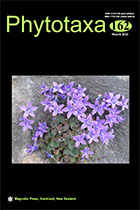Abstract
The Balkan Peninsula and the amphi-Adriatic region are biodiversity centres with a high number of Campanula species, some of them with restricted and isolated distributions. Among those is the morphologically, karyologically and genetically well-defined linage of isophyllous Campanula species of the garganica clade, taxonomically treated as Campanula ser. Garganicae. In the central Adriatic, on the Island of Vis (Croatia), an isophyllous Campanula was found growing in rocky crevices of calcareous sea cliffs among chasmophytic vegetation with extremely challenging ecological conditions. Based on morphological characters (monopodial growth form, cordate to ovate basal leaves, campanulate corolla, presence of obtuse hairs at the base of filaments, capsule opening by basal pores and brown shiny seeds) the unidentified plant from the Island of Vis falls into ser. Garganicae. To establish the phylogenetic position and relationships of the unknown Campanula among other species of the garganica clade, nuclear ITS and chloroplast trnL-F sequences as well as comparative morphology, karyology and scanning electron microscopy of seeds were used. Due to its campanulate corolla the plants from Vis are morphologically close to C. portenschlagiana from the eastern Adriatic, from which they differ in several quantitative floral characters. The karyological analysis revealed a diploid chromosome number (2n = 34), while SEM analysis showed that seed coat of new taxon has weakly striate testa, thin wavy striped radial walls and slightly marked lumen. Additionally, molecular data show that the Vis taxon is clearly separated as a distinct species from other species of ser. Garganicae. Therefore, it is described and illustrated as a new species, Campanula teutana Bogdanović & Brullo. Because of the small number of individuals within the single population, C. teutana should be included on the Red List of the vascular flora of Croatia as an endangered species (EN).

